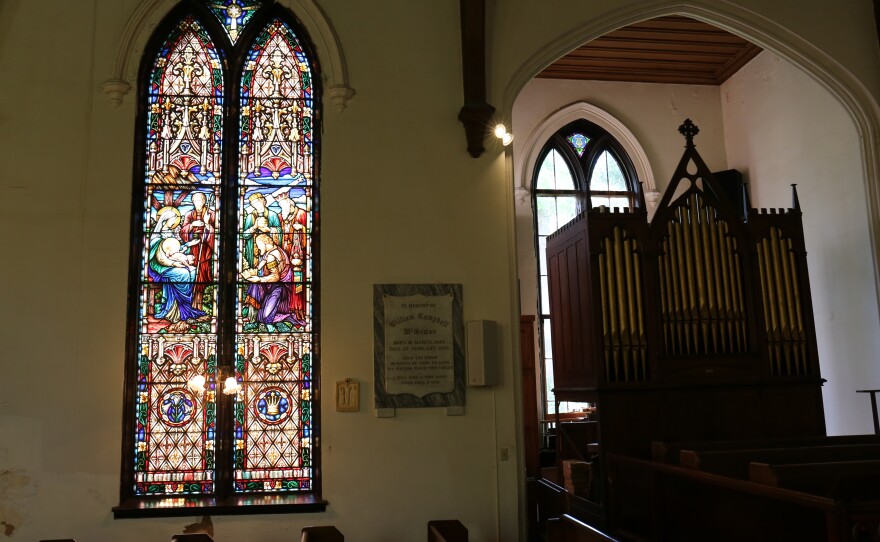South Carolina is famous for many of its structures, especially the houses of worship that dot the varied landscape of the Palmetto State. The existence of many of these structures go back over a hundred years or more. But, whether grand and ornate, or small and simple, they all require a regular amount of maintenance. However, some of those houses of worship have fallen into disrepair due to dwindling membership, or a lack of finances, causing those structures to become at risk of possibly being lost and forgotten forever.
Michael Bedenbaugh, Executive Director of Preservation South Carolina, and Bill Fitzpatrick, author of the book Sacred Spaces, have joined forces to help communities save those endangered sacred spaces that are at risk of being lost. Right now, their focus is on the town of Abbeville, SC. At the heart of the community rises the iconic 125-foot tall steeple of Trinity Episcopal Church. Its construction was envisioned by renowned South Carolina architect George E. Walker of Columbia, who is also known for his work on the South Carolina Statehouse, as well as the Governor’s Mansion.
Thanks to church leaders, congregants, and benefactors, some even living outside of Abbeville, the cornerstone of Trinity Episcopal Church was laid on June 27, 1859. The gothic-style structure featured magnificent stained glass windows by William Gibson, known as “the father of stained-glass painting in America.” To date, there are only five structures in the nation, including Trinity, which feature Gibson’s stained glass windows. Trinity was also installed with a rare John Baker tracker organ, one of only three now in existence.
But, in less than one year, war would be declared across the young nation, and nearly all resources, including finances, would be in ruins. This was the beginning of Trinity’s struggle to survive.
Not long after the United States began to recover from the devastation of the Civil War, the South experienced an attack on one of its most prolific industries: cotton. In the late 19th Century, and continuing on into the early 20th century, the boll weevil made its way from the southern Texas border, eventually chewing its way up through the southeast. Once again, the community of Abbeville, SC suffered an economic setback, as local cotton farmers, the Abbeville Cotton Mill Company, and its workers were all dealt a harsh blow. While residents searched for new hope, and new opportunities, often having to leave their once prosperous town, the nation suffered two more crises: World War I, followed by The Great Depression. It was during this time that dwindling congregation numbers and finances caused Trinity Episcopal Church to be shuttered. Although the church was officially closed from 1930 to 1949, a handful of its faithful congregants still tended to its structural needs as best as they could.
In 1971, Trinity Episcopal Church was placed on the National Register of Historic Places. In an attempt to refurbish the exterior of the aging building, well-meaning contractors covered the original lime stucco of Trinity in a fresh new layer of Portland cement. Sadly, as time passed, the cement began to crack and peel, taking away layers of the original rough cast coating, mortar, and hand-made bricks as large chunks of the Portland cement fell to the ground. Failed internal gutters and water intrusion have not only caused damage to the exterior, but to the interior of Trinity’s famed steeple, causing the 160-year-old timbers to lean.
The voice of Trinity Episcopal Church has also fallen mute. The once beautiful and rich-sounding Baker organ now sits in pieces in a box, abandoned 15 years ago by an unscrupulous repairman. In 2018, Preservation South Carolina placed Trinity on their “Places at Risk” list.
Despite the magnitude of structural repairs needed to restore Abbeville’s Trinity Episcopal Church, Mike Bedenbaugh, Bill Fitzpatrick, and the residents of Abbeville are dedicated to restoring Trinity to its former glory, and invite the public to come witness its transformation, as contractors begin fulfilling their very tall, but achievable, orders.
Although the original plan was to have the leaning of Trinity’s steeple brought back to its once sturdy, plumb position atop the church, such a herculean feat would be more costly than budgets will allow. Therefore, the second best solution has been made: to reinforce the interior of the steeple with more steel structures, ensuring the safety of all who enter Trinity, and perhaps keeping some of the unintended leaning charm of the steeple intact. At the time of its original construction, Trinity’s steeple was, by all accounts, the fourth tallest structure in South Carolina, and according to Bedenbaugh, likely the tallest church steeple in rural South Carolina.
Other restoration goals include redoing the exterior and interior stucco of the church. But the greatest restoration Preservation South Carolina and the residents of Abbeville aspire to achieve is the restoration of the spirits of all those who cast their eyes upon Trinity Episcopal Church, as it was meant to be, since the very beginning of its conception.








































